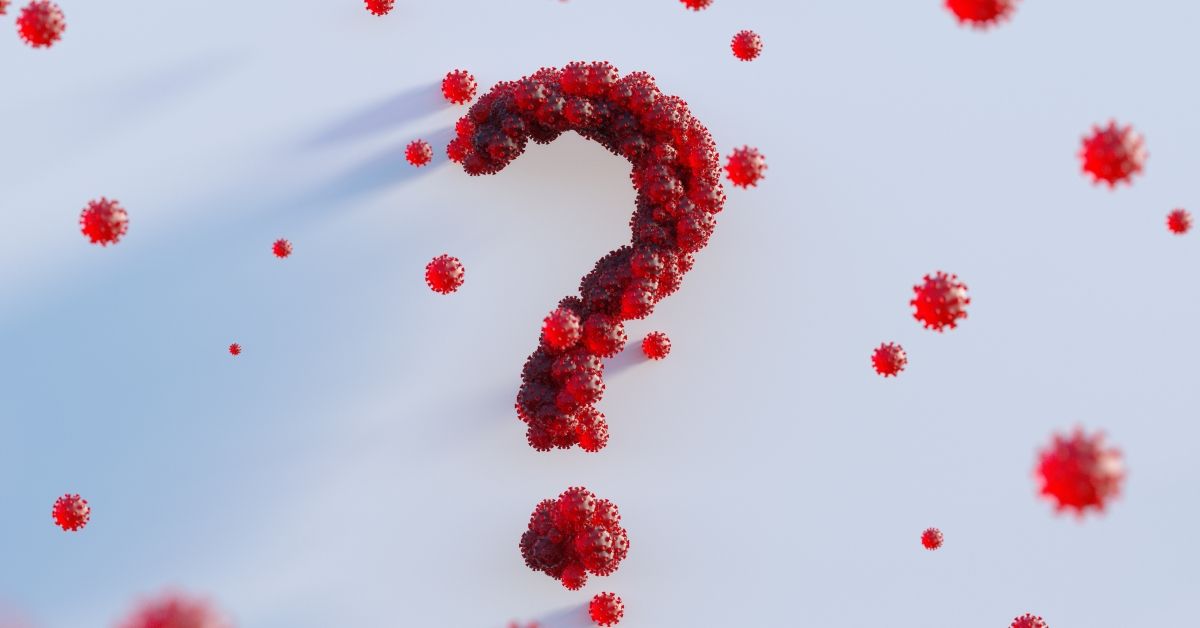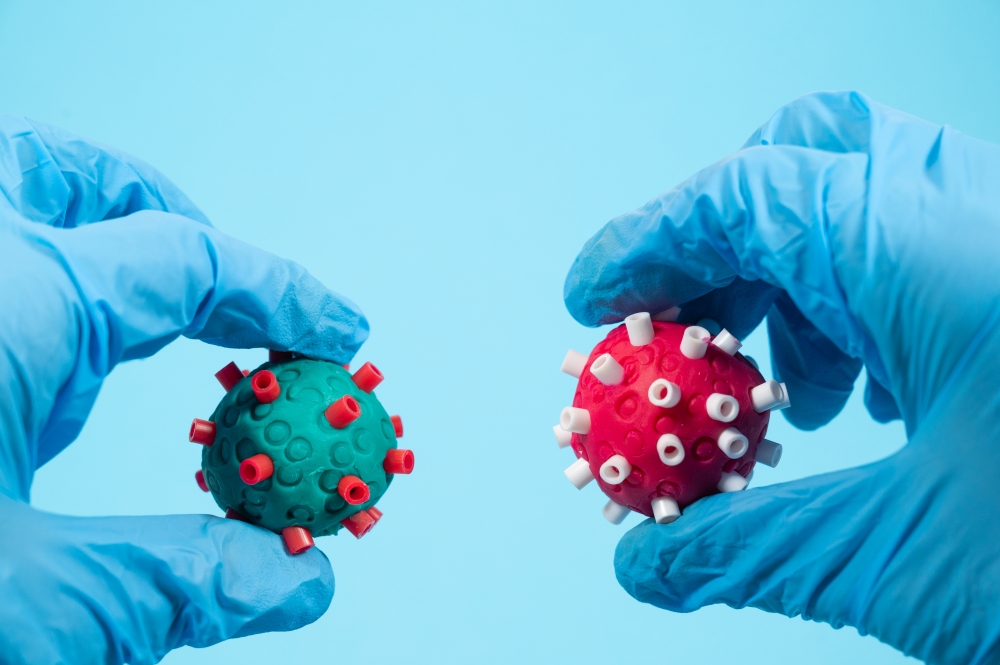As new COVID-19 cases soared in the early days of 2022, a newly coined term describing an old phenomenon also ticked its way to the top of social media platforms.
“Flurona” is used to describe an infection of both SARS-CoV-2, the coronavirus responsible for COVID-19 infection, and an influenza virus. Its catchy name brought with it a rise in internet-based misinformation that prompted alarm and concern online.
As of this writing, doctors have confirmed cases of “flurona” coinfection in Texas and California, but experts argue that there is no reason to panic nationwide. Dr. Greg Poland of the Vaccine Research Group at the Mayo Clinic told Snopes that the term “flurona” is used to describe when a person contracts influenza and COVID-19 simultaneously.
"There has been concern over a recombination event between the viruses, but no documentation [of a newly formed virus] that I am aware of," Poland added. "So, popular lore has been to call coinfection by this name."
This concept is neither new nor out of the ordinary.
A History of Coinfection: Looking Back at 1918
Such types of coinfection are not unique to SARS-CoV-2. All that is novel in 2022 is the catchy name, “flurona.” Such occurrences have been recorded since at least the so-called "Spanish Flu."
A 2008 report compiled by the National Institutes of Health found that the majority of deaths from the 1918-1919 pandemic were not caused by the influenza virus itself, but rather by bacterial pneumonia following influenza infection. Subsequent studies have confirmed such findings, furthering that it is possible some respiratory infections like influenza can impact the immune system in such a way that it allows certain bacteria to better invade the lungs and cause a severe infection.
How Common is Coinfection? Cases More Severe?
Dr. Timothy Brewer, an infectious disease physician and professor of medicine and epidemiology at the University of California, Los Angeles, sees patients with both SARS-CoV-2 and influenza. He told Snopes that health experts have been keeping an eye on such coinfections since the beginning of the COVID-19 pandemic in 2019. (That’s why diagnostic tests that include both viruses have been around since at least mid-2021.) But just how common such coinfections are is to be determined.
Doctors in Wuhan, China, analyzed more than 200 cases of COVID-19 infections documented between January and March 2020 and found that nearly half of study participants had antibodies present for both SARS-CoV-2 and influenza A — but that was also at the height of the pandemic. On the other hand, a September 2021 analysis of more than 50 studies found that coinfection occurred in just about .7% of participants, but that number varied depending on where the patient was. One set of researchers concluded that coinfection could be as high as 4.5% in Asia and as low as .4% in the Americas.
While evidence exists to suggest that coinfection could increase the risk of hospitalization or death, and may lead to greater pulmonary damage in humans, a study published in December 2021 found that by and large, coinfection does not necessarily lead to greater disease severity. Regardless, researchers argue that the likelihood of coinfection during the 2022 flu season calls for a need for screening and vaccination for both viruses.
A Competition of Viruses
Both SARS-CoV-2 and influenza are RNA respiratory viruses that spread in the same manner and tend to peak in the winter months as the U.S. has seen with Omicron.
“That having been said, you never know quite how these viruses are going to interact. There is some laboratory data to suggest that influenza A may upregulate the receptors that SARS-CoV-2 binds to,” explained Brewer. He added that some studies involving animals suggest that the two viruses may “compete” in binding to these ACE2 receptors, further reducing the likelihood of coinfection.
The big difference between the viruses is their case fatality rate. The case fatality rate for SARS-CoV-2 in early 2020 was around 1% to 1.5% globally, whereas the case fatality rate for influenza was typically 20 to 50 times lower, noted Brewer. (And no, the seasonal flu does not kill more people than COVID-19 every year in the U.S.)
SARS-CoV-2, at least right now, is a much more pathogenic and deadly virus, but those statistics may change as public health officials get more data on newly emerging variants. For example, preliminary data out of South Africa showed that the risk of being hospitalized with omicron was much lower than other variants, but if a person were hospitalized, the outcomes were largely the same.
Although rates were at over 2,000 new cases daily in early January 2022 in the U.S., compared with just over 700 new cases during that same week in 2021, deaths are about half (between two and three compared with five to six). This is in part due to background partial immunity — simply put, more people have antibodies. Two years into the pandemic, more than 206 million people had been fully vaccinated while nearly 60 million people have been infected. (Bear in mind that latter number is likely higher as people who are asymptomatic or have mild symptoms are less likely to be tested and be reported.)

Predictions for the 2022 Flu Season
As of this writing, the Centers for Disease Control and Prevention (CDC) had yet to release its forecast for the 2022 flu season. However, Brewer predicts that rates will likely still be lower than the traditional flu season because people are still abiding by COVID-19-prevention measures. Case numbers are just beginning to take off in the East and Southeast with H3N2, a type of influenza A, appearing to be the dominant strain.
“The single most important thing you can do is to get vaccinated both for influenza and SARS-CoV-2. If you’re eligible for the booster for SARS-CoV-2, definitely get it,” said Brewer, adding that early data suggests booster shots could increase antibodies for omicron between 10 and 20 times higher.
“There is good data to show that in the laboratory a booster shot, if you measure neutralizing antibodies, are anywhere from 10 to 20 times higher against omicron than if you haven’t had a booster, and in some small studies, as much as 100 times higher,” said Brewer.
If sick, experts recommend staying home. Continue to wear a mask in public, maintain physical distance, and avoid touching the face before washing hands.
Sources
“10 Misconceptions About the 1918 ‘Spanish Flu.’” Snopes.Com, https://www.snopes.com/news/2020/03/17/10-misconceptions-about-the-1918-spanish-flu/. Accessed 10 Jan. 2022.
Achdout, Hagit, et al. “Increased Lethality in Influenza and SARS-CoV-2 Coinfection Is Prevented by Influenza Immunity but Not SARS-CoV-2 Immunity.” Nature Communications, vol. 12, no. 1, Oct. 2021, p. 5819. www.nature.com, https://doi.org/10.1038/s41467-021-26113-1.
Adiga, Raghu. “'Flurona' Is a Great Example of How Misinformation Blooms.” Scientific American, https://www.scientificamerican.com/article/flurona-is-a-great-example-of-how-misinformation-blooms/. Accessed 10 Jan. 2022.
Alosaimi, Bandar, et al. “Influenza Co-Infection Associated with Severity and Mortality in COVID-19 Patients.” Virology Journal, vol. 18, no. 1, June 2021, p. 127. BioMed Central, https://doi.org/10.1186/s12985-021-01594-0.
Aug 22, Robert Roos |. and 2008. “Study: Bacterial Pneumonia Was Main Killer in 1918 Flu Pandemic.” CIDRAP, https://www.cidrap.umn.edu/news-perspective/2008/08/study-bacterial-pneumonia-was-main-killer-1918-flu-pandemic. Accessed 10 Jan. 2022.
“Bacterial Pneumonia Caused Most Deaths in 1918 Influenza Pandemic.” National Institutes of Health (NIH), 22 Sept. 2015, https://www.nih.gov/news-events/news-releases/bacterial-pneumonia-caused-most-deaths-1918-influenza-pandemic.
CDC. “COVID Data Tracker Weekly Review.” Centers for Disease Control and Prevention, 7 Jan. 2022, https://www.cdc.gov/coronavirus/2019-ncov/covid-data/covidview/index.html.
“FluSight: Flu Forecasting.” Centers for Disease Control and Prevention, 16 Dec. 2021, https://www.cdc.gov/flu/weekly/flusight/index.html.
Cheng, Yuan, et al. “Co-Infection of Influenza A Virus and SARS-CoV-2: A Retrospective Cohort Study.” Journal of Medical Virology, vol. 93, no. 5, May 2021, pp. 2947–54. PubMed, https://doi.org/10.1002/jmv.26817.
Dadashi, Masoud, et al. “COVID-19 and Influenza Co-Infection: A Systematic Review and Meta-Analysis.” Frontiers in Medicine, vol. 8, June 2021, p. 681469. PubMed Central, https://doi.org/10.3389/fmed.2021.681469.
Dao, Thi Loi, et al. “Co-Infection of SARS-CoV-2 and Influenza Viruses: A Systematic Review and Meta-Analysis.” Journal of Clinical Virology Plus, vol. 1, no. 3, Sept. 2021, p. 100036. ScienceDirect, https://doi.org/10.1016/j.jcvp.2021.100036.
“Did the CDC Recall PCR COVID-19 Tests Because They ‘Failed Full Review’?” Snopes.Com, https://www.snopes.com/fact-check/cdc-recall-pcr-covid-19-tests-failed-review/. Accessed 10 Jan. 2022.
“Gregory A. Poland, M.D.” Mayo Clinic, https://www.mayo.edu/research/faculty/poland-gregory-a-m-d/bio-00078220. Accessed 10 Jan. 2022.
Guan, Zhou, et al. “Impact of Coinfection With SARS-CoV-2 and Influenza on Disease Severity: A Systematic Review and Meta-Analysis.” Frontiers in Public Health, vol. 9, 2021, p. 1944. Frontiers, https://doi.org/10.3389/fpubh.2021.773130.
“Https://Twitter.Com/Johnshopkinssph/Status/1480612391192862729.” Twitter, https://twitter.com/johnshopkinssph/status/1480612391192862729. Accessed 10 Jan. 2022.
“Https://Twitter.Com/Maitra_sulagna/Status/1477727170281754632.” Twitter, https://twitter.com/maitra_sulagna/status/1477727170281754632. Accessed 10 Jan. 2022.
“Is Seasonal Flu More Deadly Than COVID-19?” Snopes.Com, https://www.snopes.com/fact-check/flu-kills-more-people-covid-19/. Accessed 10 Jan. 2022.
LA’s First Reported Case Of Flurona Detected At COVID Testing Site Near Getty Center. 5 Jan. 2022, https://losangeles.cbslocal.com/2022/01/05/la-first-case-flurona-detected-getty-center-covid-testing-site/.
Morens, David M., et al. “Predominant Role of Bacterial Pneumonia as a Cause of Death in Pandemic Influenza: Implications for Pandemic Influenza Preparedness.” The Journal of Infectious Diseases, vol. 198, no. 7, Oct. 2008, pp. 962–70. PubMed Central, https://doi.org/10.1086/591708.
“Mortality Analyses.” Johns Hopkins Coronavirus Resource Center, https://coronavirus.jhu.edu/data/mortality. Accessed 10 Jan. 2022.
Ritchie, Hannah, et al. “Coronavirus Pandemic (COVID-19).” Our World in Data, Mar. 2020. ourworldindata.org, https://ourworldindata.org/covid-vaccinations.
“Coronavirus Pandemic (COVID-19).” Our World in Data, Mar. 2020. ourworldindata.org, https://ourworldindata.org/covid-cases.
Short, Kirsty R., et al. “Back to the Future: Lessons Learned From the 1918 Influenza Pandemic.” Frontiers in Cellular and Infection Microbiology, vol. 8, 2018, p. 343. Frontiers, https://doi.org/10.3389/fcimb.2018.00343.
Stowe, Julia, et al. “Interactions between SARS-CoV-2 and Influenza, and the Impact of Coinfection on Disease Severity: A Test-Negative Design.” International Journal of Epidemiology, vol. 50, no. 4, Aug. 2021, pp. 1124–33. PubMed, https://doi.org/10.1093/ije/dyab081.
“Texas Physicians Monitor Flu, COVID Dual Infections after 1st Confirmed Case.” KXAN Austin, 4 Jan. 2022, https://www.kxan.com/news/coronavirus/texas-physicians-monitor-flu-covid-dual-infections-after-1st-confirmed-case/.
Timothy F. Brewer, MD | Infectious Diseases | UCLA Health. https://www.uclahealth.org/providers/timothy-brewer. Accessed 10 Jan. 2022.
“Why Hydroxychloroquine and Chloroquine Don’t Block SARS-CoV-2 Infection of Human Lung Cells.” Snopes.Com, https://www.snopes.com/news/2020/07/23/why-hydroxychloroquine-and-chloroquine-dont-block-sars-cov-2-infection-of-human-lung-cells/. Accessed 10 Jan. 2022.
Wolter, Nicole, et al. Early Assessment of the Clinical Severity of the SARS-CoV-2 Omicron Variant in South Africa. 21 Dec. 2021, p. 2021.12.21.21268116. medRxiv, https://www.medrxiv.org/content/10.1101/2021.12.21.21268116v1.

